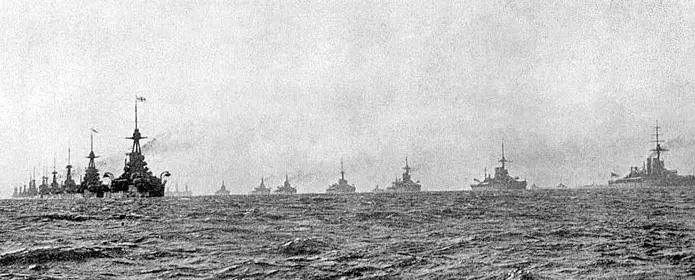HMS Caroline : Wiki Commons
The HMS Caroline, a WW1 C Class light Cruiser of the British Royal Navy and last remaining survivor of the Battle of Jutland was under threat from the scrap heap, destined for a future as razor blades.
Launched in 1914, she retained the status of being the second oldest ship in royal naval service at the time of being decommissioned in 2011, second only to the HMS Victory as well as being the last First World War British light cruiser in service.
Until recently, she served as the static headquarters and training ship for the royal naval reserve in the Alexandra Dock, Belfast.
Plans to scrap the ship for its raw metals had been proposed for August 2012, unless initial estimates of £5 million in restorations, along with a yearly £250 maintenance fee needed to be raised to ensure the survival of this historic monument to WW1’s naval warfare.

Professor Dominic Tweddle, who is director-general of the Portsmouth-based National Museum of the Royal Navy spoke to journalists as the deadline passed for heritage bids to be submitted to the Ministry of Defence. He stated..
‘We’ll save the ship, I don’t think that’s now in doubt.’
‘Everyone is agreed on her importance to the nation and how to save her,’
‘Now we’ve got to do some more work. I’m sure ministers will accept that the heritage parties can find a way forward.’
The breakthrough comes after talks with the Northern Ireland tourism minister Arlene Foster and the Heritage Lottery Fund.
Seeped in history, the Caroline was part of the Royal Navy’s Grand fleet (& now the last surviving member) that fought in the Battle of Jutland on the 31st May and 1st June in 1916. The battle comprised of the Imperial German Navy’s High Seas Fleet and Royal Navy’s Grand Fleet, comprising of 250 ships.

It was the largest naval battle and the only full-scale clash of battleships in the war. It was only the third-ever fleet action between steel battleships, following the smaller but more decisive battles of the Yellow Sea (1904) and Tsushima (1905) during the Russo-Japanese War.
During the Second World War Caroline served as the Royal Navy’s headquarters in Belfast Harbour which was used as a home base by many of the warships escorting Atlantic and Russian convoys including Captain-class frigates of the 3rd Escort Group.
Caroline retains the record of having the fastest build time of any significant warship – nine months from her keel being laid till her launch. Her Parsons steam turbines are the last surviving examples of the kind introduced after the notable event of Parson’s Turbinia cutting up the fleet at the Spithead review in 1897.
The final decision on whether the ship will remain in Belfast, or join the ranks of the Portsmouth Historic Dockyards is yet to be announced.
However, talks are underway to bring the ship to Portsmouth in 2014 to mark the 100 year anniversary of the outbreak of world war one.
At the time of her decommission the commanding officer Martin Quinn said: “The Royal Navy’s preference would be to leave her here in Belfast. What we see is the ship being part of a maritime heritage trail created with local government and local authorities.”
A spokesman for Minister Foster said: ‘Officials have had a constructive meeting with the museum of the Royal Navy on the July 18 and are continuing to work with them to find a solution.’
A spokesman for the Ministry of Defence said: ‘We’ve now received bids and will consider the future of HMS Caroline. We will make an announcement in the future.’




